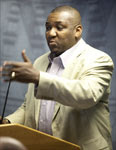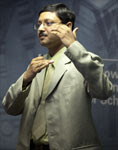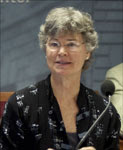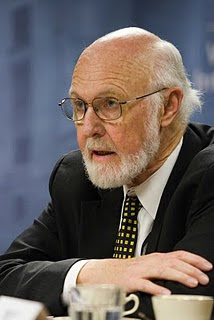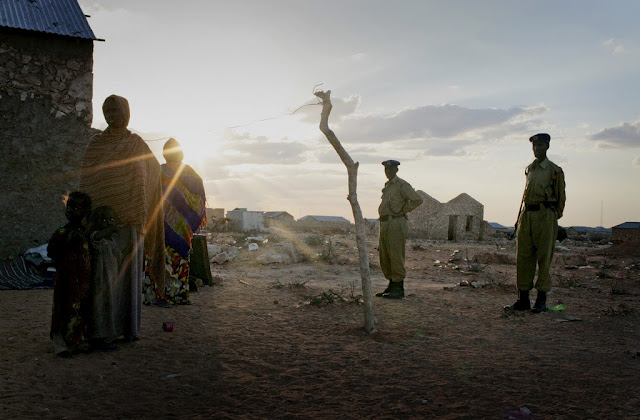-
Backdraft: The Conflict Potential of Climate Mitigation and Adaptation
›The European Union’s biofuel goal for 2020 “is a good example of setting a target…without really thinking through [the] secondary, third, or fourth order consequences,” said Alexander Carius, co-founder and managing director of Adelphi Research and Adelphi Consult. While the 2007-2008 global food crisis demonstrated that the growth of crops for fuels has “tremendous effects” in the developing world, analysis of these threats are underdeveloped and are not incorporated into climate change policies, he said. [Video Below]
-
Environmental Impacts of Madagascar’s Coup
Cutting the Head Off Conservation
›June 24, 2010 // By Tara Innes The coup in Madagascar in early 2009 not only politically destabilized the country, but also damaged its ability to protect its unique environment. A hotspot of biodiversity, Madagascar is the home of many species that exist nowhere else in the world.
The coup in Madagascar in early 2009 not only politically destabilized the country, but also damaged its ability to protect its unique environment. A hotspot of biodiversity, Madagascar is the home of many species that exist nowhere else in the world.
Deposed president Marc Ravalomanana, while criticized for prioritizing business interests, was a proponent of environmental conservation who leveraged the natural wealth of his country to promote sustainable development.
The coup caused donors to withdraw aid to the country; destroyed the tourism industry, and changed the priorities of the country’s leadership. The new government, led by President Andry Rajoelina, has failed to help—and has possibly harmed–Madagascar’s rich ecosystem.
Shortly after the coup, the United States suspended all non-humanitarian aid to Madagascar, including aid targeted at conservation efforts. The World Bank and the African Union also cut aid to the country.
Without international aid—which provides 90 percent of the funding for conservation, according to MongaBay—parks and endangered species cannot be preserved and protected. Conservation International documented reports of endangered lemurs being slaughtered and sold for bushmeat by poachers.
Funding for USAID’s integrated population-health-environment programs, which seek to improve health and reduce population pressures in remote communities near protected areas, was also suspended. Prior to the coup such programs were heralded largely as a success.
Instability has also made Madagascar an unattractive vacation destination. The tourism industry – much of it eco-tourism – has taken a massive economic hit, losing 12 percent of its value in 2009 and depriving some communities of a major source of support. The drop in tourist visits to the country’s national parks has “a big impact on the economics of the villages as 50 percent of the park entrance fees are used for village conservation and development projects,” the manager of the Ranomafana National Park told MongaBay’s Rhett Butler earlier this year.
While Ravalomanana tripled the area of protected lands in Madagascar during his tenure as president, he also made several unpopular decisions leading to rising food costs and unrest. Just prior to the coup, South Korea’s Daewoo Logistics Corporation attempted to negotiate a 99-year lease on 3.2 million hectares of farmland, contributing to anti-Ravalomanana sentiment fueled by Rajoelina, who later canceled the deal.
Some—including Ravalomanana–claim that the new government is being funded in part by illegal lumber exports. More recently, members of the transitional government banned trade in rainforest timber, but there are some concerns that this ban will not be enforceable given the continued political instability, reports MongaBay.
The damage already done “demonstrates that long-term conservation success depends on the overall political stability of a country and in turn on the steady improvement of the lives of its citizens,” wrote Rowan Moore Gerety in wildmadagascar.org last year.
“It’s difficult to work without a state,” said Guy Suzon Ramangason, director general of the organization that manages many of the national parks, recently told the New York Times.
Perhaps that situation will be rectified. In May Rajoelina announced that elections will be held in late 2010, in which he will not be running. Until then, it unlikely that conservation will receive adequate attention—from either Madagascar’s government or international donors.
Photo Credit: “Lemur behind the mesh” courtesy of flickr user Tambako the Jaguar -
Women Deliver: Real Solutions for Reproductive Health and Maternal Mortality
›The landmark Women Deliver conference, which concluded last week, reinvigorated the global health community’s commitment to improve reproductive health at both the grassroots and global levels. Providing a major boost was the Gates Foundation’s announcement that it will commit an additional $1.5 billion over the next five years to support maternal and child health, family planning, and nutrition programs in developing countries.
“We haven’t tried hard enough,” said Gates Foundation co-founder Melinda Gates. “Most maternal and newborn deaths can be prevented with existing, low-cost solutions.” Examples of these efficient and effective solutions were presented at the three-day conference’s dozens of panels on a wide range of issues, including climate change, contraceptive commodities, fistula, gender inequities, adolescent family planning, communications and technology, and much more.
Empowering Young Girls to Access Family Planning
“When we speak about adolescents we typically think of prevention. However, we must also think about providing access to safe abortions and supporting young women who want to be mothers and empower young women to make choices,” said Katie Chau, a consultant at International Planned Parenthood Federation.
In Nigeria, “there is not much attention on adolescent sexual and reproductive health, even though a majority of rapes occur before the age of 13, and the rate of teenage pregnancy and abortions is high,” said Bene Madunagu, chair of the Girls’ Power Initiative (GPI) in Nigeria. GPI teaches girls about their rights to make decisions, including those regarding sex and reproductive health, as well as improving their critical thinking skills, self-esteem, and body image. “Girls develop critical consciousness and question discriminatory practices, while also learning about the legal instruments to take up their concerns,” he said.
Sadaf Nasim of Rahnuma Family Planning said child marriages are common in his country, Pakistan. “Marriage is an easy solution for poor families. Once a girl is married she is no longer the responsibility of the family,” he explained.
While laws in Pakistan and other parts of the developing world condemn child marriage, the prevalence of child marriage remains high: 49 percent of girls are married by age 18 in South Asia, and 44 percent in West and Central Africa. Nasim said birth registration at the local and national levels should be improved to prevent parents from manipulating their daughter’s age.
In Kyrgyzstan, “community-based efforts worked to galvanize media attention and disseminate information to demonstrate the need for improved adolescent family planning,” said Tatiana Popovitskaya, a project coordinator with Reproductive Health Alliance of Kyrgyzstan. Such community-based approaches use grassroots education to mobilize community leaders, which is a critical step in overcoming child marriage and other harmful traditions.
Cell Phones and Maternal Health
“There is a lot of information being collected, but it is not necessarily going where it needs to because of fragmentation,” said Alison Bloch, program director at mHealth Alliance. In developing countries, the people most in need are often the most isolated, but mobile technology is emerging as a way to bridge the gaps.
According to a recent report by mHealth Alliance, 64 percent of mobile phone users live in developing countries and more than half of people living in remote areas will have mobile phones by 2012. The potential for improving global health with cell phones and PDAs is significant, and can address a wide range of health issues, such as human resource shortages and information sharing problems between clinics and hospitals.
“Mobile technology provides benefits to individuals, institutions, caregivers, and the community. It reduces travel time and costs for the individual, improves efficiency of health service delivery, and streamlines information to health workers to reduce maternal mortality,” said Elaine Weidman, vice president of sustainability and corporate responsibility at Ericsson.
“Mobile technology is the most rapidly adopted technology in history and represents an existing opportunity to reach the un-reached,” said Fabiano Teixeira da Cruz, a program manager for the Inter-American Development Bank, speaking of the benefits of using mobile technology to train field-based healthcare workers in Latin America.
While mobile phones are indeed reaching parts of the world not currently equipped with quality healthcare, the lack of systematic coordination and infrastructure at the district and regional levels must also be addressed, as highlighted during a recent Wilson Center event, Improving Transportation and Referral for Maternal Health.
Read about our first impressions of Women Deliver 2010 here.
Calyn Ostrowski is program associate with the Wilson Center’s Global Health Initiative
Photo credit: Woman and child in South African AIDS clinic, courtesy Flickr user tcd123usa. -
Book Review: ‘Climate Conflict: How Global Warming Threatens Security and What to Do About It’ by Jeffrey Mazo
›June 8, 2010 // By Dan Asin The heated back-and-forth over climate conflict in the blogosphere and popular press prompts the questions: In the debate over the security threat of a warming planet, who is spewing the hot air? Does climate change precipitate conflict, and if so, who is most at risk?
The heated back-and-forth over climate conflict in the blogosphere and popular press prompts the questions: In the debate over the security threat of a warming planet, who is spewing the hot air? Does climate change precipitate conflict, and if so, who is most at risk?
In Climate Conflict: How Global Warming Threatens Security and What to Do About It, Jeffrey Mazo unabashedly argues that weak–but not yet failed–states are at the greatest risk of climate-driven conflict. Packed into only 166 pages, the book takes readers on a crash course through climate science; 10,000 years of human-environmental history; case studies of the pre-modern South Pacific and modern-day Colombia, Indonesia, and Darfur; and analysis of geopolitical instability and stressors. This tour d’horizon all builds up to one point: Global warming and climate change threaten our security.
Key to Mazo’s work is the important but oft-overlooked insight that it is not the magnitude of climate change, but the difference between the rate of climate change and a society’s ability to adapt that threatens stability. He also confronts the all-too-common assertion that accepting climate change as a threat multiplier absolves individuals of culpability, and is explicit that intrastate–rather than interstate–conflict is the norm.
The Weakest Are Not the Greatest Threat
Mazo weaves threads of non-traditional and human security throughout the text, asserting that “there is no real contradiction between humanitarian and security goals” (pg. 132). However, his primary concern is the security of the nation-state and the international system. He argues that the next two to four decades are the most relevant time for strategic planning.
Within this context, Mazo claims global warming’s central security challenge will be the threat it poses to stability in states that are either unable or unwilling to adapt. Few will be surprised, therefore, when he says weak, fragile, and failing states appear the most vulnerable.
Mazo suggests that already fragile or failed states lying in climate-sensitive areas–namely a handful of states in sub-Saharan Africa, plus Haiti, Iraq, and Afghanistan–are the most likely to experience increased volatility as a result of warming-induced climate change. Yet he departs from received wisdom when he suggests that global warming’s greatest threat to international security is actually how it will impact more resilient states like Burkina Faso, Colombia, and Indonesia.
Precisely because they are less at risk, the onset of instability in these states would have a greater impact. Exacerbating conflict or instability in a fragile or failed state, such as the Democratic Republic of Congo, would not ripple through the international security framework in dramatically new ways. But the results of new conflict or instability in relatively stable states, such as Colombia, would. Mazo believes that the greater quantitative and qualitative impact of conflict in more resilient states renders them greater areas of concern.
Climate Factor Is One of Many
In no instance will climate change be the sole factor in conflict or state collapse. In already fragile or failed states, such as Sudan, instability is the product of a complex range of factors–political, social, and economic–many of which are non-environmental. “No single factor is necessary or sufficient,” writes Mazo (p. 126).
As it becomes increasingly pronounced, climate change may play a larger role in contributing toward volatility and instability. It is unlikely, however, to precipitate conflict where other risk factors do not already exist.
Adaptation Is Key
To address the threat to otherwise stable countries, Mazo advocates improving their latent capacity for adaptation. Good governance, rule of law, education, economic development: each is a key factor in a state’s ability to adapt. Variations across these factors may explain why death tolls from natural disasters in Bangladesh have fallen in recent years while those in Burma have risen.
Adaptation efforts should prioritize weak or recovering states that “have proved able to cope but are at particular risk,” Mazo writes (p. 133). Failing or failed states are either too susceptible to other conflict factors or too far advanced along the path of instability for adaptation to be of use to forestalling threats to international security. His argument is not to consign those in the most dire circumstances to a perpetual state of misery but, from a security perspective, to focus constrained resources on states where they will have the greatest impact. In states with the capacity to effectively absorb inflows, adaptation can preempt conflict, not simply reduce it.
Mazo does not ignore mitigation, and recognizes that it works in tandem with adaptation: Mitigation “is the only way of avoiding the most dire consequences of global warming, which would exceed the capacity of individuals, nations or the international system to adapt,” he notes (p. 124). Nevertheless, he argues that mitigation strategies “take much longer to bear fruit,” and that a certain amount of warming in the short- to medium-term is inevitable (p. 133). Against this warming, resilient adaptation is our best defense.
Case in Point: Indonesia
One otherwise stable state whose stability is threatened by climate change is Indonesia. Having suffered political and social unrest following the Asian financial crisis in 1997 and sectarian violence following Timor Leste’s independence in 1999, Indonesia avoided both failure and collapse to emerge as a flawed but vibrant democracy and Southeast Asia’s largest economy.
Indonesia is now home to the largest Muslim population in the world and is a key to regional security, yet its success “is potentially threatened by climate change,” writes Mazo; “food insecurity will be the greatest risk” (pg. 116).
Annual mean temperatures in Indonesia rose by 0.3°C between 1990 and 2005, and are predicted to rise an additional 0.36-0.47°C by 2020. The rainy seasons will shorten, increasing the risk of either flooding or drought. El Nino weather patterns–which in 1997 damaged over 400,000 hectares of rice and coffee, cocoa, and rubber cash crops–are expected to become more extreme and frequent in the future.
Climate change will further widen the substantial wealth gap between Indonesia’s rich and poor and, when it has differential impacts in different regions, “could lead to a revival of separatism” (pg. 117). While Mazo says threats from climate change will not be enough to push Indonesia into instability by themselves, he warns that if other destabilizing factors begin to emerge, “the added stress of climate change could accelerate the trend” (pg. 117).
Short and Sweet
Unlike some popular commentators on climate and security, Mazo does not confound brevity with hyperbole. While its concise format best lends itself to policymakers, students, and curious readers who are short on time, Climate Conflict’s content and its compendium of more than 320 citations make it deserving of a spot on everyone’s bookshelf. -
Improving Transportation and Referral for Maternal Health
›“Referral has been called an orphan cause,” said Patricia Bailey, public health specialist for Family Health International and Columbia University, because it is “everybody’s responsibility and therefore nobody’s responsibility.”
As part of the Maternal Health Dialogue Series the Woodrow Wilson International Center for Scholars’ Global Health Initiative convened a small technical meeting on May 19, 2010, with 25 experts from five countries to discuss their experiences and share lessons, challenges, and recommendations for improving transportation and referral for maternal health. Following the technical meeting, a public dialogue was held on May 20, 2010, to share the knowledge gaps and recommendations identified. The formal report from the technical meeting will be available in the near future.
Mobilizing District Communities in Rural Ghana
To improve maternal health care in Ghana, “we needed to shift [services] to the community level, where 70 percent of our population lives,” said Dr. John Koku Awoonor-Williams, the east regional director of Ghana Health Service. The “Community-based Health Planning and Services” (CHPS) program was created to galvanize local leadership and empower communities to engage in health outreach activities.
Through this approach, “community health officers and nurses are trained and delegated to distant village locations called CH[I]P zones, in which they are responsible for health education, treatment of minor illnesses, maternal and antenatal care, and referral to district hospitals for emergency care,” said Awoonor-Williams. Community health officers use two-way Motorola walkie-talkies to communicate with traditional birth attendants and referral centers. Pregnant women are given the phone numbers so they can call in the event of complications.
1-0-8 Emergency Number for Improving Maternal Health in India
Many parts of the developing world do not have a 911-style emergency response service. To address this gap, the GVK Emergency Management & Research Institute in India developed the toll-free 1-0-8 telephone number for all medical, police, and fire emergencies.
“We assure every citizen that wherever you are, [if] you call us we will be there,” said Subodh Satyawadi, chief operating officer of GVK. In order to reach the 433 million people covered by GVK, they have:
“Although we address all kinds of emergencies, we heavily focus on maternal health…31 percent of emergencies are pregnancy-related,” said Satyawadi, who said that GVK’s emergency response system has helped save more than 200,000 mothers. Institutional deliveries have increased in the state of Gujarat by 92 percent. “We have been able to reduce maternal mortality by 20-25 percent in different geographies,” he said.- 19,623 EMTs and 10,000 doctors and other healthcare professionals
- 2,710 ambulances
- 16,300 call-center employees
Pre-Hospital Barriers: Reducing Maternal Morbidity in Bolivia
Women in Bolivia receive free maternal care. In cities like La Paz, emergency obstetric care is often available within a short distance. However, “37 percent of our maternal deaths [occur] at our hospitals,” said Víctor Conde Altamirano, OB/GYN of CARE Bolivia.
To better understand this mortality rate, Altamirano evaluated whether pre-hospital barriers and routine antenatal care are associated with near-miss morbidity. He found that women who are older, have lower levels of education, lack antenatal care, are pregnant for the first time, or live in rural areas are at a greatest risk of illness or death
“We are trying to organize our communities and service facilities, and promote improved health management by the municipalities. If our authorities can be sensitive and invest in health; invest in fuel, drugs, and human resources; we can improve near-miss morbidity rates,” said Altamirano.
Strategies and Recommendations for Improving Transportation & Referral
The workshop participants agreed on six key topic areas for improving transportation and referral:1. Multi-sectoral collaboration
The group called for improved multi-sectoral engagement and continuous dialogue among key ministries: Health, Finance, Communication, Social Welfare, Security and Defense, Transportation, and Public Works.
2. Mobile phone technology
3. Public-private partnerships
4. Referral for newborns
5. Indicators for referral
6. Sharing evidence
Private-public partnerships, such as those demonstrated by GVK in India and the CH[I]P program in Ghana, create opportunities for collaboration. “Cell-phone technology can reduce delays in transport and treatment by identifying which facilities might be the most appropriate for referral,” said Bailey.
The final recommendation by the group calls for increased pooling and use of existing evidence to move the transportation and referral agenda forward. Updated synthesis papers on existing evidence are needed, said Bailey. “We have a lot of data that is perhaps less than perfect, but this should not be a barrier for further action,” she said. -
VIDEO: Family Planning in Conflict Areas
›“Displaced people are like every other human being, they want, they need the advantage of family planning. They are asking only for services to be available for them, affordable for them, and acceptable for them,” said Dr. Grace Kodindo in a recent interview with ECSP about the challenges of family planning in conflict regions. The OB/GYN from Chad calls for family planning services to be included in the provisions made for displaced and refugee communities.
Kodindo identified five key barriers to family planning for displaced people, including a lack of coherent policies for displaced people in host countries and a lack of awareness and attention by donors to family planning. Other barriers include the lack of access in remote areas, and a lack of knowledge and therefore demand.
However, in many cases family planning services are very much in demand. One refugee mother compared herself to a “hen being followed by many chicks,” said Kodindo, who “ask[s] the government and the donors to give and to make policy that can really facilitate the provision of services and to provide funding so that services can be available to all these people.”
Kodindo, who recently spoke at a Wilson Center panel on “Family Planning in Fragile States,” is also speaking in DC on Thursday, June 3 at a showing of the documentary about her work in the Democratic Republic of the Congo, Grace Under Fire. -
‘Frontlines’ Interviews John Sewell: “Promoting Development Is a Risky Business”
›May 31, 2010 // By Wilson Center Staff Q: Foreign assistance has had major achievements over the past 50 years. What are some examples?
Q: Foreign assistance has had major achievements over the past 50 years. What are some examples?
SEWELL: There have been many but off the top of my head I can think of three. First, the Green Revolution where the combined efforts of American aid and private foundations revolutionized agriculture in Asia. As a result, many more people lived a much longer time. Second, the efforts put into improving education, particularly of women and girls. The third is population growth. When I started working on development, the best predictions said that global population would rise to over 20 billion at the end of the 20th century. Now we know it will not go much above 9 billion and perhaps lower. That wouldn’t have happened without American leadership and funding.
Q: What are the major failures of foreign assistance?
SEWELL: Failures have occurred either because countries were not committed to development, or because aid agencies designed ineffective programs. But most major failures came about because aid was provided for political reasons— for Cold War purposes in Southeast Asia or the Middle East, not for economic and social development. And we should remember that promoting development is a risky business. If there were no failures, development agencies were being too cautious.
But the more important failures are at the strategic level. Assistance really is only effective when governments and leaders want to speed economic growth, improve health and education, and address poverty. When the government isn’t committed to development, a lot of aid is wasted.
That’s why the choice of countries is so important. Korea is one example. Korean leaders knew how to use foreign aid effectively to build agriculture and industry. Part of that assistance funded investments in health and education. We all know the result.
Egypt, on the other hand, also has received large amounts of American assistance since 1979. But its growth rates are low and they still have one of the highest rates of adult illiteracy in the world.
Perhaps the largest failure has been in Africa. Except for a small number of countries, Africa lags far behind other regions. The blame lies not just with African leaders but also with aid donors who have continued to provide assistance in ways that hinder development.
Q: In what ways can global poverty be reduced quickly in the next three to four years?
SEWELL: In the short term, it won’t happen. The global financial crisis makes that a certainty.
The best estimates are that up to 90 million people will fall back into poverty because they will have lost jobs and livelihoods. The most important thing the U.S. can do in the near term is to continue to lead the reform of the international financial systems that are essential to restarting global economic growth, particularly in the developing world.
Q: That’s the way to reduce poverty?
SEWELL: In the short term, yes. But the U.S. can target aid to build poor peoples’ capacities and can make a great difference. That means aid for education, especially women, and to enable poor people to improve their health. And jobs are critical.
I think the right goal is to empower people to move into the middle class.
That means helping to provide technical assistance and in making low-cost credits for both farmers and small scale entrepreneurs. They will be the generators of jobs that enable men and women to move out of poverty.
Q: Why do you say in one of your papers that economic growth alone will not eliminate poverty?
SEWELL: Because it’s true. Growth does not automatically diminish poverty; it has to be complemented by government actions to share the gains from growth by investing in better health and education. For this you also need a competent state. That’s how the East Asian countries managed to develop so successfully. On the other hand, many Latin American countries have grown at decent rates but have lousy income distribution. But now countries like Brazil are starting to change. For instance, the Brazilian government now pays mothers to keep their children in school where they can get education and health care.
Q: USAID has restrictions that inhibit advertising. How can the public and Congress be informed about the successes and importance of development assistance?
SEWELL: USAID has been very timid about educating the public and Congress. I am not even sure that the earlier successful programs of development education exist anymore. Some steps are easy.
USAID staff knows a lot about development. Why not send them out to talk to public groups around the country? USAID staff doesn’t even participate actively in the yeasty dialogue on development that goes on in the Washington policy community and they should be encouraged to do so. Other changes may require funding and perhaps legislation and the administration should work with the Congress to get them.
Informing the public is particularly important now when there are two major processes underway to modernize U.S. development programs and Congress is rewriting the development assistance legislation.
Q: Since China and Vietnam have both developed without democracy, how important is it to push for democracy and good governance? Are they really necessary?
SEWELL: We need to separate democracy and governance. Very few of the successful developing countries have started out as democracies; India is the big exception. On the other hand, all of the successful countries have had effective governments to do what governments should do: provide security and public goods like health and education, establish the rule of law, and encourage entrepreneurship.
We need to face the fact that no outsider, including the U.S., can “democratize” a country. But it can play an important role in helping to improve governance in committed poor countries. And one of the important parts of successful development is what a Harvard economist calls “conflict mediating institutions” that allow people to deal with the inevitable conflicts that arise within successful development.
Q: You have said that we need to make markets work. How can we help poor people begin to trade when Europe, Japan, and the United States either block imports or subsidize exports?
SEWELL: If you are serious about development, you have to give high priority to trade policy. Unfortunately, USAID seems to have very little voice in trade decisions.
The U.S. needs to focus its development trade policy on the poorest countries. The highest priority should be dropping the remaining subsidies for U.S. production of highly subsidized agricultural products like cotton that can be produced very competitively in very poor countries.
But many of these countries have difficulty selling goods in the U.S., not only because of subsidies, but also because they are not equipped to export. Transport costs are high as are the costs of meeting U.S. health and quality standards, and knowledge of marketing in America is scarce.
Here’s where USAID can play an important complementary role. U.S. companies are already providing technical assistance, some with USAID support. But USAID can expand its trade capacity building programs and focus them on the poorer countries.
Q: What about microcredit?
SEWELL: Microcredit is a very important innovation, especially for empowering poor people, particularly poor women. It’s part of the solution to ending poverty.
But there are other needs. In most poor countries, there are large groups of poor entrepreneurs who are not poor enough to get microcredit but who can’t get commercial banks to lend to them. These are people who produce products for sale— handbags, for instance—that employ 10 to 20 people, but they need capital and advice in order to grow. In the U.S., small businessmen used to borrow money from local banks.That’s how America grew. But similar institutions don’t exist in many poor countries.
Q: We are involved in so many different programs—20 or 30 different federal agencies do some sort of foreign assistance— why not just invest in education and health and let each country figure out what their own development plan should be?
SEWELL: A very good idea. I have long advocated that the U.S. should focus its programs on a few major development issues but I would go beyond just health and education. I add climate change and dealing with global health threats. We dodged the bullet on SARS [severe acute respiratory syndrome] and avian flu but we may not be so lucky in the future. And strengthening governance and strengthening weak states is essential.
The real need now is for some mechanism that oversees and coordinates the multiplicity of agencies that have programs and expertise on these critical issues. Let’s hope that emerges from the current administration’s reviews of development policy
John Sewell a senior scholar at the Woodrow Wilson International Center for Scholars, was interviewed by FrontLines Editorial Director Ben Barber. Originally published in USAID FrontLines, April 2010.Can Food Security Stop Terrorism?
›May 28, 2010 // By Schuyler NullUSAID’s “Feed the Future” initiative is being touted for its potential to help stabilize failing states and dampen simmering civil conflicts. Speaking at a packed symposium on food security hosted by the Chicago Council last week, USAID Administrator Rajiv Shah called food security “the foundation for peace and opportunity – and therefore a foundation for our own national security.”
Showing posts from category Africa.





